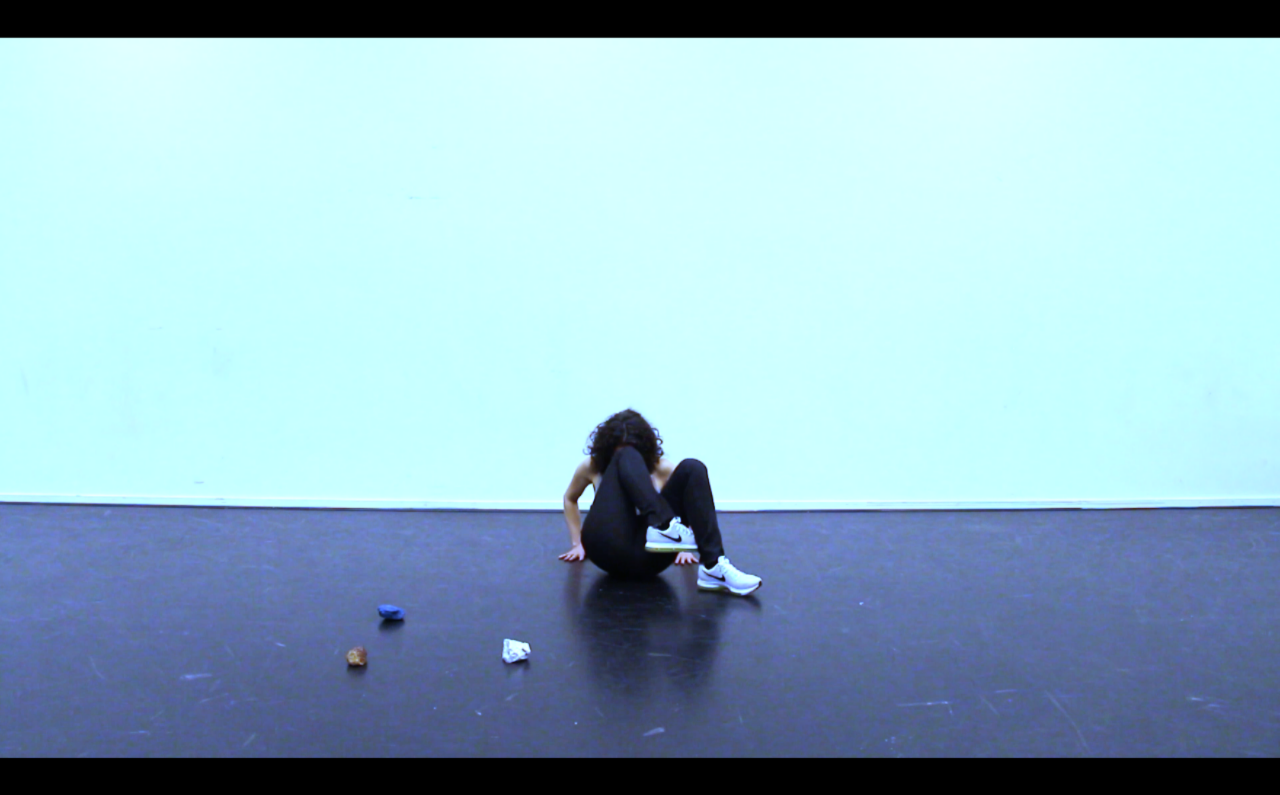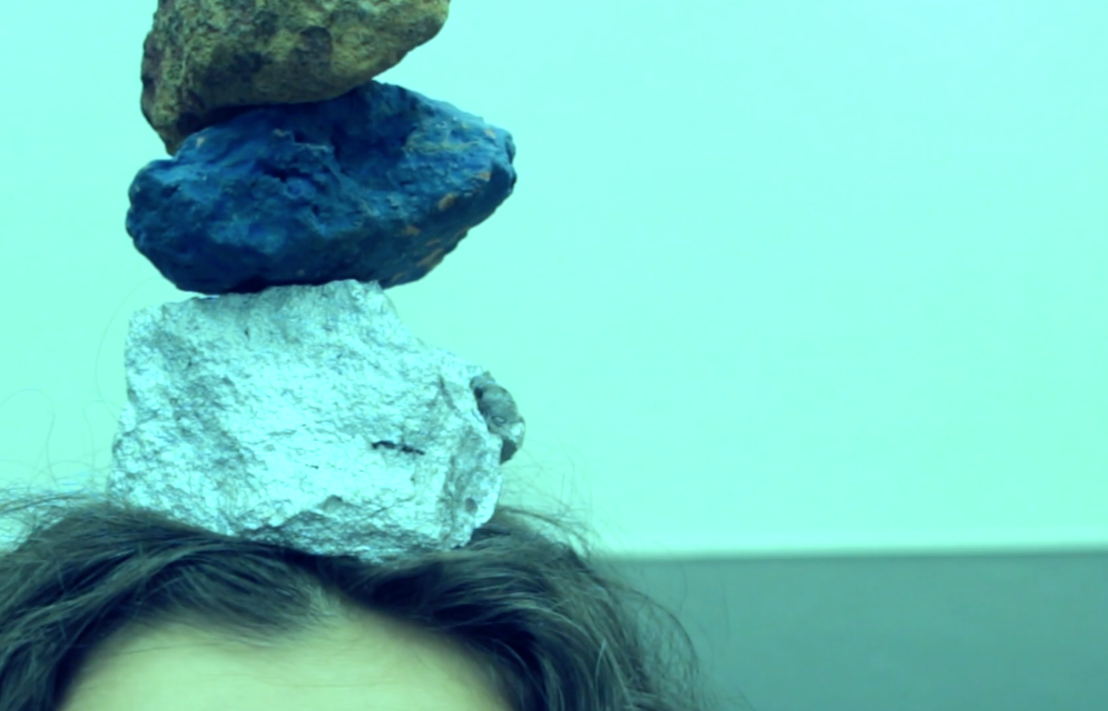2021
Landing Intimacy
> a scored dialogical practice between a human and a thing> a video based on documentation of studio practice
> a reflection

ROCK. MILK. SOIL. SKIN. STONE. ITA. CLOT. HEART. RANA. BLOOD. MAGMA. KIDNEY. MOUNTAIN. GLAND. SOFT. METEORITE. VISCOUS. HARD. HOT. LAND. ESCAPE. SCOPE. BODY. GRAVESTONE. WEATHER STONE. STEPSTONE. TOUCHSTONE. MAZE. PHILOSOPHER’S STONE. HARD ROCK. SISIPHUS. BREAST. MONOLITH. FRACTURE. AMULET. ROLL. TOUCH. A-MAZED. ATOM. MOLECULE. VIBRATION. COMPRESSION. TEXTURE. BOUNCE. MEDUSA. STONE. A-STONISHED.
The Landing Intimacy score is a dialogic practice between a human and one or more extrahuman thing(s).
In this practice, all materials are relevant and useful.
Keywords: attention / vitality / displacement / forces / capture / transmit / thisness
In this practice, all materials are relevant and useful.
Keywords: attention / vitality / displacement / forces / capture / transmit / thisness
> Guidelines <
to human:
Listen to the music and rhythm of your breath
to thing:
Perceive the contours of your partner’s physical body. Sense the air you exchange
Sense the intersections of your electromagnetic fields
to human:
Place you ear to the ground in order to listen to your partner’s voice
Say out loud fragments of what you hear
to human-thing:
Observe each other’s multiple textures
If you feel like experiencing touch, now is the time
to human-thing:
Whether you are touching or not, notice what makes your partner describable as “this one”
Can you name this quality?
to human:
Listen to the music and rhythm of your breath
to thing:
Perceive the contours of your partner’s physical body. Sense the air you exchange
Sense the intersections of your electromagnetic fields
to human:
Place you ear to the ground in order to listen to your partner’s voice
Say out loud fragments of what you hear
to human-thing:
Observe each other’s multiple textures
If you feel like experiencing touch, now is the time
to human-thing:
Whether you are touching or not, notice what makes your partner describable as “this one”
Can you name this quality?
Landing Intimacy (2021) is a video created from the documentation of studio practice of the Landing Intimacy score.
The creation of Landing Intimacy has been a continuation of my practice around dialogical choreographic scores for humans and extrahuman things. These dialogues are central in my current practice-based research project Amazonizing Practices: processes of thinking-moving with a landscape.
Within a field of investigation at the crossroads between choreography, Amazonian studies and philosophy, the research starts from the urgency to reconsider and learn with ways of knowing, being-becoming and moving in the world that have been invalidated by colonial processes. I propose an approximation to a possible Amazonian landscape as a decolonial practice, focusing on the dimensions that actualize Indigenous knowledge systems as they contribute to form the cultural, affective and mythic meshwork that shapes the contemporary Amazonian landscape.
In this research, the verb (to) amazonize, addresses the interest in the doing, in the construction of places that are not necessarily functional spaces, but multidimensional landscapes to be practiced. In these landscapes, the power of things is summoned by acts of re-enchantment.
In order to create Landing Intimacy, I have displaced traces of the Amazonian landscape across the Atlantic Ocean into a performance space in Arnhem, Nehterlands, and practiced the score with them. By questioning the affordances of three displaced rocks, I attempted to design a score drawing from Ben Spatz’s ideas regarding 'embodiment as first affordance' (2017). I aimed to generate a dialogical relation that would point towards bodily experiencing, imagining and speculating on the rocks' haecceity, i.e., what makes each of them recognizable as this one. By approaching each rock in its thisness as well as my own body as landscapes, I investigated relationality between materials, between organic and inorganic, between micro and macro, noticing how different distances between things suggested possible topographies of intimacy.
Noticing that the relation rising between human and extrahuman landscapes could also be perceived as a thing, I became interested in the quality of intimacy. Their intimacy did not necessarily demand close proximity, but a specific quality of attention, which I connect to the act of tunning proposed by Spatz (2017). The idea of perceiving matter as continuous to the human body turned the practice into a sensual, erotic experience, which is also an extension of the experience I had in the Amazon Forest during the Fall 2020, when I collected the rocks. Practicing a landscape through both dialogical dynamics and memory has reminded me of the explicit connection between the female body and natural landscapes explored by Brazilian pop culture in the 1980s and 90s. I recalled the transforming, merging and overlapping of beautifully designed mountains, hips, trees, breasts, butts and felines. Probably all created by male directors who, either consciously or not, emphasized the patriarchal perspective that connects women to nature and man to culture, in this hierarchical order respectively.
In Brazilian Portuguese, the expression 'to milk a rock', refers to working on something which will bring no results. When imagining and practicing, at times in a quite literal gesture, breastfeeding a rock, I realized that such inversion—giving instead of taking— to an extrahuman thing had a direct link to the Amazonian philosophies I have been researching. The inversion of the dialogical dynamics between a human body and a thing, the human offering rather that taking from, or even proposing a symbiotic connection could be an entrance point to such philosophical stances.
I have also considered the intersections between the fields of geology and biology, particularly when reflecting upon the affordances of rocks. Both the human body and rocks contain high amounts of minerals, these being one of the four groups of essential nutrients humans need for survival, but which they cannot synthesize. The rocks I correspond with in the Landing Intimacy Practice would be situated within the field of geology. However, any type of rock created by my own body though the amalgamation of things, would be situated within the field of biology. This is one of the divisions between epistemes constructed by modern Western thought, which proposed a separation between nature and culture. The Amazonizing Practices operate within a paradigm that intends to un-do such borders, as proposed by Donna Haraway when adopting the term natureculture (2016).
Wondering what knowledge could be transmitted, or even generated in such symbiotic relation, I recalled a situation that happened the year I relocated to Poland to join a dance company. Of course, as a Brazilian person, I was freezing during the Polish winter, specially living in an apartment that was never warm enough. One day I told an older woman that I was constantly cold at night. She then suggested that I collect rocks from the streets, keep them near the radiator for them to absorb the heat during the day and place them under my blanket during the night. At the time, the idea amused me, and I did not sleep with rocks. At this moment, I no longer need such strategy, but I finally get the idea of reconnecting to our environments in ways that propose modes of collaboration, modes of relating that may reveal affordances.
According to the cosmologies of many Amazonian populations, geographical formations, animals and bodies of water have a human background. In the beginning there were only humans, then some of them transformed into things and extrahuman animals. There is kinship and familiarity between species and things that Western culture considers non-living. Approaching the Indigenous Amazonian perspective, I began to experiment on ways of thinking-moving and becoming with the rocks in order to open spaces for attachment. For thousands of years, rocks have been central in cosmologies and mythologies of many different cultures. For a long time I have been connected to certain rocks as amulets and I view the relation between myself and such things as kinship. By becoming with a thing, affordances are revealed.
I realized the nuances of the Landing Intimacy practice could not be perceived through the screen and demanded a non-frontal spatial relation to the spectator. Working with landscape dramaturgy, as proposed by Anna Vujanović (2018), I intend to avoid imposing a single point of view to the spectator, what conflates the dramaturgical choices and the political implications of the research. So, I decided to use the documentation of the studio practice to create a video inspired by Brazilian pop culture, particularly soap opera’s video introductions. However, I have transposed this language to year 2051. Landing Intimacy is happening in another space intersecting Amazonian ancestral knowledge and posthuman philosophy. By shifting perspective and temporality, I attempted to delve into an erotic dialogue with extrahuman matter, partially exposing my own body-landscape. As proposed by the score, I worked with air and sound as means to bridge the bodies across the space, regarding breathing, listening and voicing as alternative forms of touch during the current pandemic times. Landing Intimacy became a dialogue between human and extrahuman things that are all amalgamations of substances with unknowable histories.

Landing Intimacy unfolded from the study module “INTRAPLACES: dialogic experience of place and geographies of difference”, led by Dr. Elena Cologni in February 2021 in the frame of the Master Performance Practices programme at ArtEZ University of the Arts, Arnhem, Netherlands.
References Haraway, D. J. (2016). Staying with the Trouble: Making Kin in the Chthulucene. Durham: Duke University Press.
Spatz, B. (2017). Embodiment as first affordance. Tinkering, tuning, tracking. PERFORMANCE PHILOSOPHY, vol. 2, no. 2, 257-271.
Vujanović, A. (2018). Landscape Dramaturgy: Space after Perspective. Available at: https://www.academia.edu/37812064/Landscape_dramaturgy_Space_after_perspective